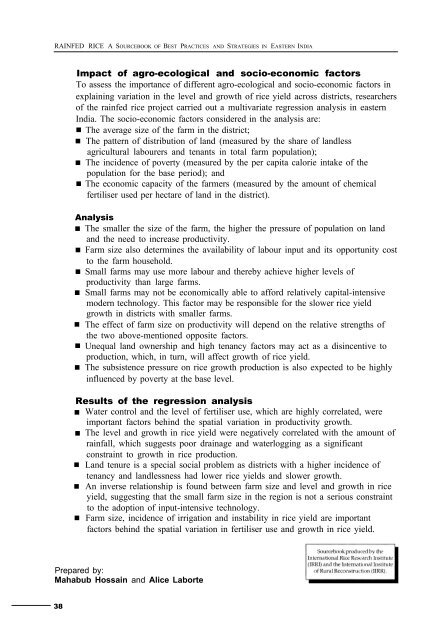Rainfed rice - IRRI books - International Rice Research Institute
Rainfed rice - IRRI books - International Rice Research Institute
Rainfed rice - IRRI books - International Rice Research Institute
Create successful ePaper yourself
Turn your PDF publications into a flip-book with our unique Google optimized e-Paper software.
RAINFED RICE A SOURCEBOOK OF BEST PRACTICES AND STRATEGIES IN EASTERN INDIA<br />
Impact of agro-ecological and socio-economic factors<br />
To assess the importance of different agro-ecological and socio-economic factors in<br />
explaining variation in the level and growth of <strong>rice</strong> yield across districts, researchers<br />
of the rainfed <strong>rice</strong> project carried out a multivariate regression analysis in eastern<br />
India. The socio-economic factors considered in the analysis are:<br />
The average size of the farm in the district;<br />
The pattern of distribution of land (measured by the share of landless<br />
agricultural labourers and tenants in total farm population);<br />
The incidence of poverty (measured by the per capita calorie intake of the<br />
population for the base period); and<br />
The economic capacity of the farmers (measured by the amount of chemical<br />
fertiliser used per hectare of land in the district).<br />
Analysis<br />
The smaller the size of the farm, the higher the pressure of population on land<br />
and the need to increase productivity.<br />
Farm size also determines the availability of labour input and its opportunity cost<br />
to the farm household.<br />
Small farms may use more labour and thereby achieve higher levels of<br />
productivity than large farms.<br />
Small farms may not be economically able to afford relatively capital-intensive<br />
modern technology. This factor may be responsible for the slower <strong>rice</strong> yield<br />
growth in districts with smaller farms.<br />
The effect of farm size on productivity will depend on the relative strengths of<br />
the two above-mentioned opposite factors.<br />
Unequal land ownership and high tenancy factors may act as a disincentive to<br />
production, which, in turn, will affect growth of <strong>rice</strong> yield.<br />
The subsistence pressure on <strong>rice</strong> growth production is also expected to be highly<br />
influenced by poverty at the base level.<br />
Results of the regression analysis<br />
Water control and the level of fertiliser use, which are highly correlated, were<br />
important factors behind the spatial variation in productivity growth.<br />
The level and growth in <strong>rice</strong> yield were negatively correlated with the amount of<br />
rainfall, which suggests poor drainage and waterlogging as a significant<br />
constraint to growth in <strong>rice</strong> production.<br />
Land tenure is a special social problem as districts with a higher incidence of<br />
tenancy and landlessness had lower <strong>rice</strong> yields and slower growth.<br />
An inverse relationship is found between farm size and level and growth in <strong>rice</strong><br />
yield, suggesting that the small farm size in the region is not a serious constraint<br />
to the adoption of input-intensive technology.<br />
Farm size, incidence of irrigation and instability in <strong>rice</strong> yield are important<br />
factors behind the spatial variation in fertiliser use and growth in <strong>rice</strong> yield.<br />
Prepared by:<br />
Mahabub Hossain and Alice Laborte<br />
38

















